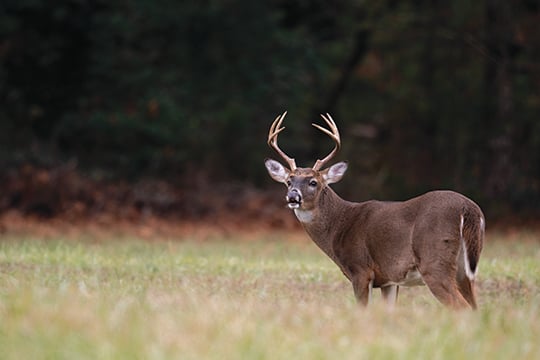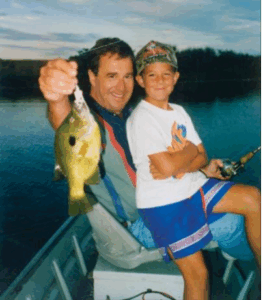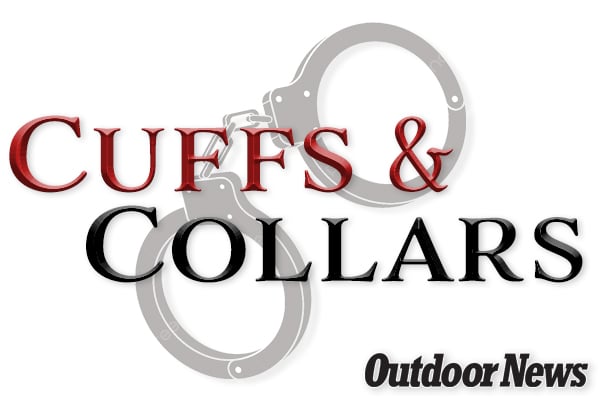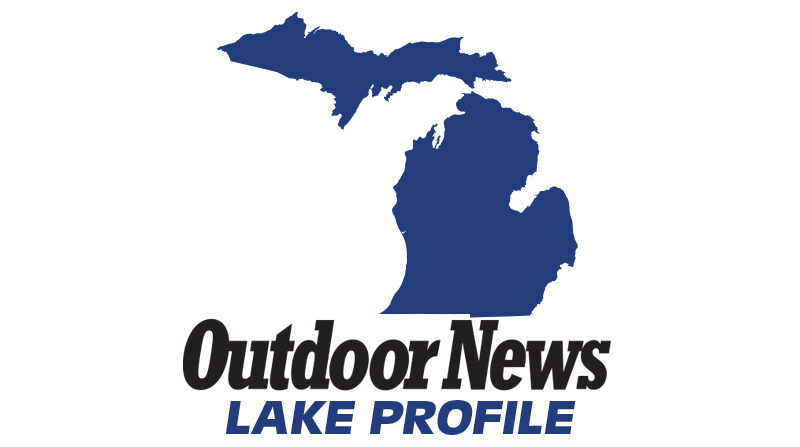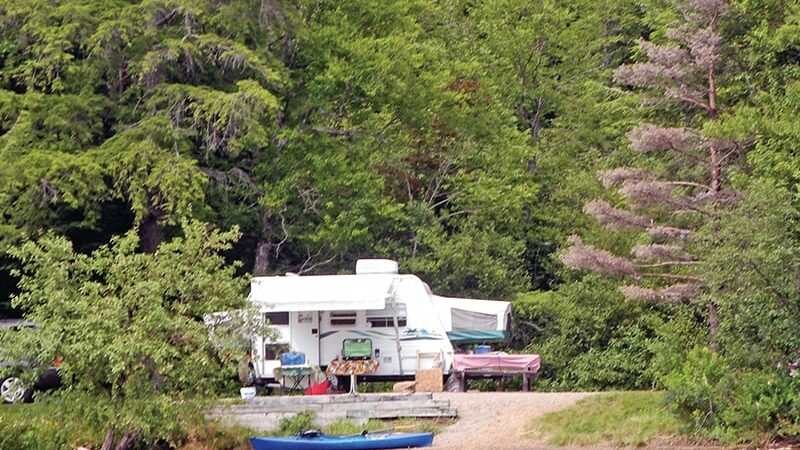Goats, grit and persistence: Illinois wildlife habitat benefitting from ag improvements – Outdoor News
Editor’s Note: A pair of young biologists authored the following report, which originally appeared in the Outdoor Illinois Journal. Emily Hodapp, a Private Lands Biologist for the U.S. Fish and Wildlife Service, and Zach Stephenson, a Farm Bill Biologist for Pheasants Forever and Quail Forever, assisted Dr. Shirley Johnson on the project. “Dr. Johnson’s edge of field practices are undoubtedly benefiting wildlife,” Stephenson said. “She is restoring this farmland by utilizing practices that benefit both production and wildlife, especially for quail and pollinators.”
Dr. Shirley Johnson wasn’t anticipating restoring her woodland with a herd of goats when she inherited her family homestead. Her initial goal was to maintain the working farm that has been in her family for more than 100 years, despite increasing pressure from development. From saving the farm to saving the savanna, Johnson’s journey has taken her on many routes where she has faced and overcome numerous challenges.
Persistence
In 2011, Johnson faced her first significant challenge: development. Johnson, her sister, and neighbors utilized resources from American Farmland Trust and the Illinois Department of Agriculture to provide input on re-zoning proposals. Their efforts helped to limit habitat fragmentation.
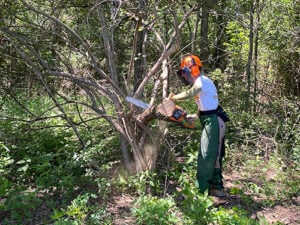
After successfully advocating for farmland preservation, her next step was to tackle production on the farmland she inherited in 2019. Her father farmed with an environmentally sensitive ethic including no-till, though he relied on chemicals for weed control. She wanted to carry on his legacy, while utilizing her own experiences gained through a career in biotechnology to implement conservation and nutrient loss reduction practices.
“I first focused on improving 60 acres of tillable land by working with a local farmer to transition to certified organic row crops,” Johnson said. “I also implemented conservation practices including a denitrifying bioreactor, prairie strips and a dry dam.”
Johnson’s commitment to improving agriculture productivity while providing wildlife habitat is paying off.
Johnson’s edge of field practices are undoubtedly benefiting wildlife. She is restoring this farmland by utilizing practices that benefit both production and wildlife, especially for quail and pollinators.
Last year, a brood of quail made their home in Johnson’s tomato garden, then moved into the prairie grasses. It was the first time she had seen quail on the property since she was a child.
MORE COVERAGE FROM ILLINOIS OUTDOOR NEWS:
Bill giving Illinois DNR control over gray fox seasons advances
Goats
In 2022, Johnson’s land management focus shifted from her agriculture fields to her 110 wooded acres. Once utilized for cattle grazing, the previous oak woodland became dominated by undesirable Osage orange, sugar maple and black locust trees when the cattle were removed. Invasive species, including bush honeysuckle, multiflora rose and autumn olive, took over the forest floor, occupying the entire understory. All is not lost.
DNR District Forester Tom Branson, who is assisting with the woodland restoration, noted, “There are numerous white oaks that show characteristics of growing in open, savanna habitat. By implementing habitat management practices like brush and tree removal, these oaks can be saved and the savanna can be restored.”
Standard practices to remove undesirable woody species involve herbicide use. However, Johnson converted her farm to organic production, a certification that prohibits the use of synthetic herbicides.
Additionally, with a Ph.D. in chemical engineering, Johnson is keenly aware of impacts chemicals can have on the environment.
“I would like to avoid the use of herbicides, despite their widespread acceptance, because I want to protect the environment from widespread chemical use,” she explained.
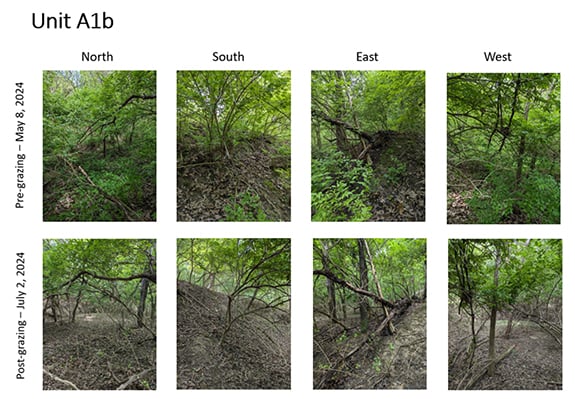
Her solution: goats.
Johnson researched, designed, and implemented a 20-acre forest management study that utilizes a combination of biological control (aka goats), mechanical control, hand clearing and prescribed fire to begin restoring her woodland and savanna. Fire is a key component in restoring her habitat that naturally depends on fire to thrive. Currently, the forest composition of invasive and undesirable woody species is preventing her from implementing a prescribed fire.
“A prescribed burn, necessary to improve forest health, is simply not possible because there is no fuel for a fire,” she noted. Her study is looking at non-herbicide methods of woody management control and what combination of treatments best prepare a site for a prescribed burn.
So far, the goats are doing an outstanding job. In the spring of 2024, they opened the understory of the woods by defoliating everything they could reach, clearing bush honeysuckle, multiflora rose, and autumn olive up to 6 feet high. Several units in the study were then followed-up with pulling, cutting and grinding of the remaining woody brush and small diameter undesirable trees. The goats will return this spring to eat any resprouting vegetation. The goal is to conduct a prescribed burn in the fall to further knock back brush species.
Grit
This study has been more than a comparison of restoration methods, it has been a test of determination. One of Johnson’s first hurdles was finding enough goats to intensely browse the study area. The original study design called for 300 goats, which proved to be unrealistic.
Johnson modified her study to accommodate a smaller herd, but still had trouble finding a suitable contractor. After months of searching, Johnson found there were no contractors available in Illinois with enough goats to treat her study area of 20 acres. She found many goat grazing companies have too few goats and prefer jobs with smaller acreage. After many failed attempts to secure a goat grazing contract, Johnson was able to find an out-of-state contractor to deliver 100 adult doe goats.
Lessons learned continued. Steep terrain coupled with the extremely dense honeysuckle understory proved incredibly difficult to set up fencing for the paddocks. Johnson estimated 20 to 30 days to complete the goat grazing treatment, but the added difficulties of fencing extended that time. It took 42 days. When seeing setting fencing was becoming too much of a challenge for the contractor, Johnson stepped in to help by routing out fence lines, clearing brush and setting fence posts.
Every restoration project has its own unique set of challenges. A successful restoration project takes a dedicated landowner who is willing to put in the hard work to get the job done and who can encourage others to join the project.
Partnerships
Johnson’s creativity and determination are driving factors in her farm’s success, and her positive outlook and desire to be a good steward of the land have drawn a team of conservation professionals to assist with her restoration journey. Mike McKim, owner of Invasive Plant Removal and Maintenance, is one of those folks involved in Johnson’s restoration efforts. McKim feels there is something special about Johnson, saying “I have worked with many landowners and land managers in my career, and there just aren’t many people like her. She knows what she wants, and she is determined to get there. She has a clear vision, and I want to help her get there.”
Other organizations helping Johnson fulfill her vision are DNR’s Illinois Recreational Access Program, DNR’s Division of Forestry, Pheasants Forever, U.S. Department of Agriculture North Central Region Sustainable Agriculture Research and Education (SARE) Program, USDA Natural Resources Conservation Service and The U.S. Fish and Wildlife Service’s Partners Program. These partners are working together to provide Johnson technical assistance, labor and financial support.
Johnson’s restoration projects, particularly the SARE goat grazing study, have been incredibly valuable. Lessons learned from this project are being utilized by area private lands specialists to assist other landowners with similar restoration projects.

